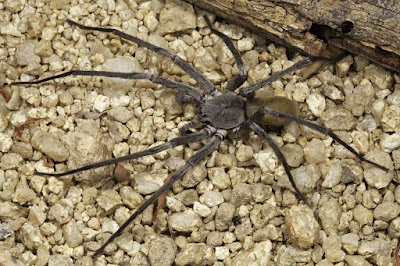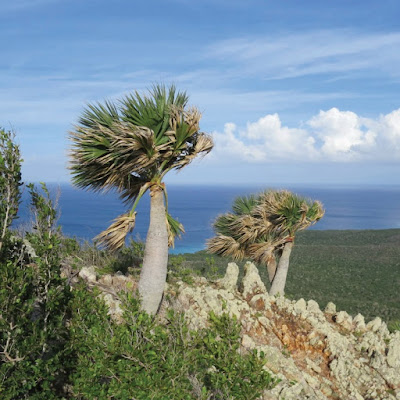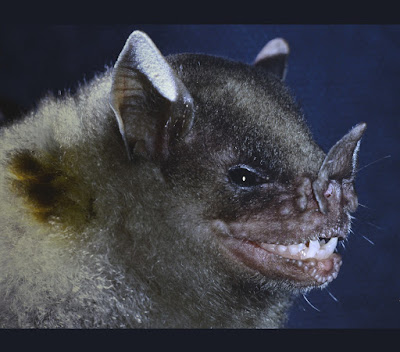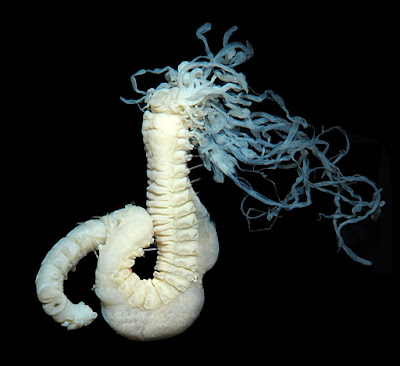[Most Recent Entries] [Calendar View]
Monday, April 10th, 2017
| Time | Event | ||||||
| 5:31a | [Arachnida • 2017] Califorctenus cacachilensis • A New Genus and Species of Cavernicolous Spider (Araneae: Ctenidae: Cteninae) from Mexico
Abstract Califorctenus gen. nov. (Araneae: Ctenidae) a new genus and a new species (Califorctenus cacachilensis sp. nov.) from the Baja California Peninsula in Mexico are described and illustrated. Califorctenus gen. nov. can be diagnosed by the morphology of the male palp, with embolus cylindrical and elongated, locking lobes of embolus positioned retrolaterally and the cup-shaped and elongated median apophysis. Keywords: Araneae, taxonomy, new species, Baja California Sur
Califorctenus new genus Type species. Califorctenus cacachilensis sp. nov. here designated. Included taxa. Only the type species, Califorctenus cacachilensis sp. nov. Etymology. The genus name is derived from the combination of “Califor” in reference to the word “California” and “Ctenus”. The gender is masculine. Diagnosis. Califorctenusgen. nov. resembles species of Amauropelma, Thoriosa and Trogloctenus by the morphology of the epigynum, with laterally elongated median fields that are curved dorsally to form a pocket (Fig. 6B) and basas lateral projections of the epigynum (Fig. 6A). Califorctenusgen. nov. can be distinguished from them by the morphology of the male palp, with embolus cylindrical and elongated, locking lobes of embolus positioned retrolaterally and median apophysis cup-shaped and elongated. Distribution. Califorctenus gen. nov. is found in México in the state of Baja California Sur. Califorctenus cacachilensis new species Holotype. Male: MEXICO: Baja California Sur, Municipality of La Paz, Sierra de las Cacachilas, Los Pisos C. Palacios and J. Maya (CARCIB 0027). Etymology. The specific name is a noun in apposition taken from the type locality.
Califorctenus cacachilensis sp. nov. C. Egg sac. D. Ocular area, anterior view. María Luisa Jiménez, James Edwin Berrian, Daniele Polotow, Carlos Palacios-Cardiel. 2017. Description of Califorctenus (Cteninae, Ctenidae, Araneae), A New Spider Genus from Mexico. Zootaxa. 4238(1); 97–108. DOI: 10.11646/zootaxa.4238.1.7 International Team Discovers Large Cave-Dwelling Spider in Baja California caves | ||||||
| 6:03a | [Botany • 2017] Sabal antillensis • A New Palmetto Species (Arecaceae) from the Leeward Antilles
Abstract A new species of palmetto, Sabal antillensis, native to Curaçao and Bonaire, is described and illustrated. The new species is characterized by a pachycaulous habit, a compact crown of leaves, large seeds, and frequent fiber bundles in leaflet transection. Details on history, morphology, distribution, habitat, and conservation status are provided. Keywords: anatomy, Coryphoideae, Christoffelpark, Palmae, palms, Southern Caribbean, Monocots
Sabal antillensis M.P.Griff., sp. nov. Diagnosis:— This new species is most similar to Sabal causiarum in leaf morphology and inflorescence structure, but differs in the pachycaul habit, the petioles less than half the total leaf length giving a distinctive densely foliated crown, the smaller and less persistent ligules, the more divided leaf segments and leaf segment apices, the frequent adaxial fiber bundles between most secondary minor leaf segment veins, the inflorescences not pendant below the leaves, the abaxially lepidote sheathing inflorescence bracts, the lower density of flowers on the rachilla, the tubular to cupulate calyx, the larger fruits and the larger seeds. Distribution:— This species occurs on the islands of Bonaire and Curaçao. On Bonaire, the plants are found in the southern part of the island, west of Lac Bay and north of the solar salt factory. On Curaçao, the plants are within and to the west of Christoffelpark, on the western side of Christoffelberg. Habitat:— On Bonaire, the plants are found in the Coccoloba–Melocactus Middle Terrace landscape type (de Freitas et al. 2005), on limestone pavements, at elevations near 5 m. On Curaçao, the plants are found in the Bromelia– Schomburgkia Hills landscape type (Beers et al. 1997), on cherty mudstones, at elevations between 140–260 m. Local Names:— The plant is called Cabana or Sabalpalm in the Dutch Caribbean. Etymology:— The name honors the Dutch Antilles, where the species is endemic. M. Patrick Griffith , John De Freitas , Michelle Barros and Larry R. Niblick. 2017. Sabal antillensis (Arecaceae): A New Palmetto Species from the Leeward Antilles. Phytotaxa. 303(1); 56–64. DOI: 10.11646/phytotaxa.303.1.4 | ||||||
| 6:05a | [Mammalogy • 2017] Sturnira adrianae • A New Polytypic Species of Yellow-shouldered Bats, Genus Sturnira (Chiroptera: Phyllostomidae), from the Andean and Coastal Mountain Systems of Venezuela and Colombia Abstract Sturnira is the most speciose genus of New World leaf-nosed bats (Phyllostomidae). We name Sturnira adrianae, new species. This taxon is born polytypic, divided into a larger subspecies (S. a. adrianae) widespread in the mountains of northern and western Venezuela, and northern Colombia, and a smaller subspecies (S. a. caripana) endemic to the mountains of northeastern Venezuela. The new species inhabits evergreen, deciduous, and cloud forests at mainly medium (1000–2000 m) elevations. It has long been confused with S. ludovici, but it is more closely related to S. oporaphilum. It can be distinguished from other species of Sturnira by genetic data, and based on discrete and continuously varying characters. Within the genus, the new species belongs to a clade that also includes S. oporaphilum, S. ludovici, S. hondurensis, and S. burtonlimi. The larger new subspecies is the largest member of this clade. The two new subspecies are the most sexually dimorphic members of this clade. The smaller new subspecies is restricted to small mountain systems undergoing severe deforestation processes, therefore can be assigned to the Vulnerable (VU) conservation category of the International Union for Conservation of Nature (IUCN). Keywords: Mammalia, Andes, evolutionary species concept, geographic variation, morphometrics, sexual dimorphism
• Sturnira adrianae new species • Sturnira adrianae adrianae new subspecies Adriana’s Yellow-shouldered Bat Murciélago de Charreteras de Adriana Diagnosis. Epaulettes (yellow shoulders) present. Lower molars with continuous lingual cusps. All four lower incisors well developed, bilobed. Upper middle incisor long, bilobed, pointed, strikingly protrudent, tip laterally diverging. Lower canine long, narrow. Upper premolars broad and long in labial view. Molars with no gaps between them. Zygomatic arch complete, not bowed outwards. Occiput low. Preorbital frontal ridges well developed. Foramen ovale touching the caudal pterygoid process. Distribution. Known from all the Andean and coastal mountain systems of Venezuela, except those east of the Unare Depression. Presumably, also distributed throughout the Cordillera Oriental in Colombia ..... Etymology. The epithet adrianae, a feminine noun in the genitive case, is dedicated to the memory of the Colombian-Venezuelan bat biologist, Adriana Ruiz, 1971–2012. Adriana was a charismatic, imaginative, and dedicated colleague. She published 14 papers and book chapters. Owing to her untimely departure, much of her most valuable research was left unpublished. Adriana had a particularly keen interest in species of Sturnira. We are privileged to name after her a member of the genus wandering in the environments in which she so joyfully conducted much of her field work. • Sturnira adrianae caripana new subspecies Caripe Yellow-shouldered Bat Murciélago de Charreteras de Caripe Diagnosis. Identical to that of S. a. adrianae, except for: 1) upper premolars narrower and shorter in labial view; 2) preorbital frontal ridges little developed; 3) foramen ovale not touching the caudal pterygoid process. Distribution (Fig. 1). Known from four localities in the Turimiquire Massiff, and from two localities in the neighboring Paria Peninsula (Appendix). Presumably, endemic to the mountain ranges of northeastern Venezuela, east of the Unare Depression. Etymology. The epithet caripana [Carip(e) + -ana], a feminine adjectival toponym, is derived from Caripe, a town near the type locality made known to science in the book “Travels to the Equinoctial Regions of America, During the Years 1799–1804”, of the famous German explorer and naturalist Alexander von Humboldt. Jesús Molinari, Xiomar E. Bustos, Santiago F. Burneo, M. A. Camacho, S. A. Moreno & Gustavo Fermin. 2017. A New Polytypic Species of Yellow-shouldered Bats, Genus Sturnira (Mammalia: Chiroptera: Phyllostomidae), from the Andean and Coastal Mountain Systems of Venezuela and Colombia. Zootaxa. 4243(1); 75–96. DOI: 10.11646/zootaxa.4243.1.3 New leaf-nosed bat uncovered amidst burning habitat in Venezuela https://news.mongabay.com/2017/04/new-le | ||||||
| 6:48a | [Invertebrate • 2017] The Genus Thelepus Leuckart, 1849 (Annelida, Thelepodidae) in Brazil, with A Redescription of the Holotype of T. setosus (Quatrefages, 1866)
Abstract The genus Thelepus Leuckart, 1849 is well known in Brazilian waters, from a species recorded by several authors as T. setosus (Quatrefages, 1866), which is considered to be a cosmopolitan species. However, the type locality of T. setosus is in France, which renders the presence of this species in Brazilian waters rather unlikely. The wide range of distribution of T. setosus is most likely due to misidentifications, especially because the original description of the species is very brief and does not include several characters now relevant at species level. We provide herein a redescription of the holotype of T. setosus and describe two new species from Brazilian material previously identified as belonging to that species. Thelepus megalabiatum n. sp. is characterised by having an expanded lower lip extending ventrally, many branchial filaments, originating from swollen cushions, with wide mid-dorsal gap between filaments within pairs, 26–33 segments with glandular areas, and 44–61+ pairs of notopodia. Thelepus brevitori n. sp. is characterised by having fewer branchial filaments, originating directly from the body wall, about 17 segments highly glandular ventrally, and up to 27 pairs of notopodia. Both new species are compared to the most similar congeners, including T. setosus. Keywords: Annelida, Polychaeta, taxonomy, morphology, Phenacia setosa, new species, outhwestern Atlantic
Etymology. We attribute the epithet “brevitori” to this taxon in reference to the narrow width of the neuropodial tori along the body. Orlemir Carrerette, João Miguel de Matos Nogueira and Pat Hutchings. 2017. The Genus Thelepus Leuckart, 1849 (Annelida, Thelepodidae) in Brazil, with A Redescription of the Holotype of T. setosus (Quatrefages, 1866). Zootaxa. 4250(6); 587–599. DOI: 10.11646/zootaxa.4250.6.6 |
| << Previous Day |
2017/04/10 [Calendar] |
Next Day >> |















